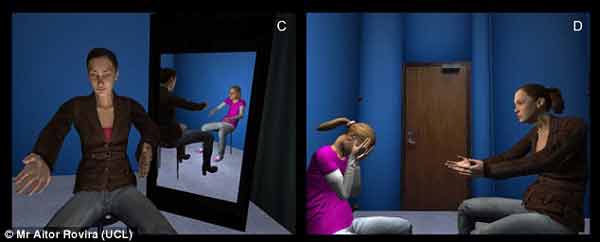當(dāng)前位置: Language Tips> 流行新詞
分享到
阿凡達(dá)療法,是科學(xué)家受阿凡達(dá)的“化身”技術(shù)啟發(fā),將虛擬現(xiàn)實(shí)用在抑郁癥治療上的一種新型技術(shù)。技術(shù)的關(guān)鍵是讓患者把一個(gè)虛擬的自己當(dāng)成自己的“化身”,讓虛擬成人安慰自己,從而擺脫抑郁癥的困擾。

Patients wore a virtual reality headset to see from the perspective of a life-size 'avatar' or virtual body. Seeing this virtual body in a mirror moving in the same way as their own body typically produces the illusion that this is their own body. This is called 'embodiment'.
患者頭戴一個(gè)虛擬現(xiàn)實(shí)頭盔后, 可看到一個(gè)與自己大小一樣并動(dòng)作同步的虛擬形象,會(huì)把這個(gè)形象看做自己的“化身”,以他/她的視角來(lái)看待外物。
While embodied in an adult avatar, participants were trained to express compassion towards a distressed virtual child.
在“化身”為成人阿凡達(dá)后,。研究人員讓患者通過(guò)這個(gè)“化身”安慰一個(gè)虛擬出來(lái)的悲傷男孩,
As they talked to the child it appeared to gradually stop crying and respond positively to the compassion.
在患者與這名男孩交談后,男孩逐漸不再哭泣,對(duì)安慰作出積極回應(yīng)。
After a few minutes the patients were embodied in the virtual child and saw the adult avatar deliver their own compassionate words and gestures to them.
幾分鐘后,研究人員讓患者把這個(gè)虛擬男孩當(dāng)做自己的“化身”,讓虛擬成人安慰虛擬男孩。
This brief eight-minute scenario was repeated three times at weekly intervals, and patients were followed up a month later. Of the 15 participants, nine reported reduced depressive symptoms a month after the therapy.
這個(gè)過(guò)程持續(xù)8分鐘,每星期重復(fù)3次。一個(gè)月后,9名患者癥狀減輕,其中4名顯著減輕。
Virtual reality has also previously been used to treat psychological disorders including phobias and post-traumatic stress disorder, but this research focused on a new application for promoting emotional well-being.
虛擬現(xiàn)實(shí)技術(shù)此前已被用于治療多種心理障礙,如恐懼癥、創(chuàng)傷后應(yīng)激障礙等,但此次研究聚焦于改善患者心理健康這一新領(lǐng)域。
部分中文素材來(lái)自互動(dòng)百科
(中國(guó)日?qǐng)?bào)網(wǎng)英語(yǔ)點(diǎn)津 yaning)
上一篇 : 每逢佳節(jié)胖三斤了嗎?
下一篇 :
分享到
關(guān)注和訂閱


口語(yǔ)
關(guān)于我們 | 聯(lián)系方式 | 招聘信息
電話(huà):8610-84883645
傳真:8610-84883500
Email: languagetips@chinadaily.com.cn